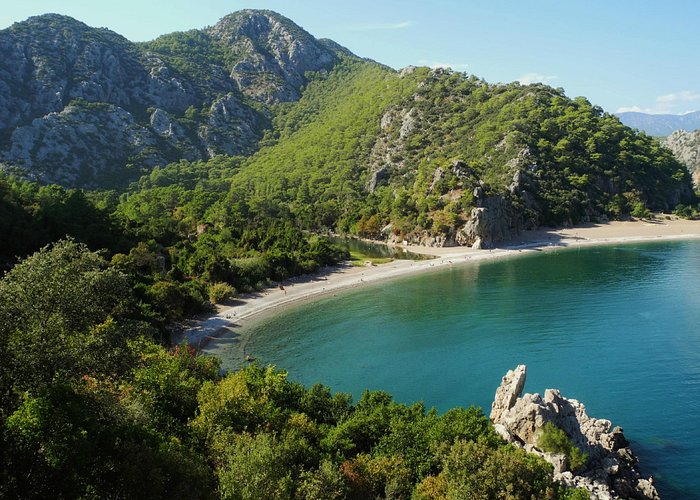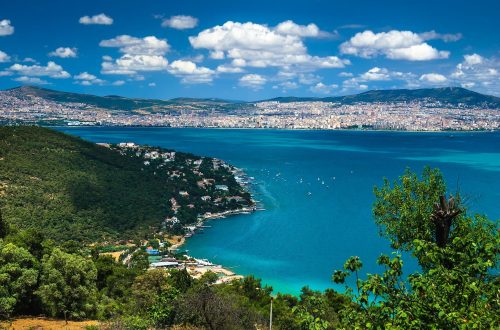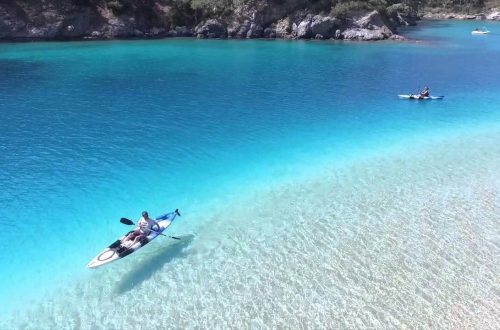
Olympos Beach
Olympos Beach: Beach vacation amidst a nature reserve
The ruins of the ancient city of Olympos (near Cirali) remains almost unretouched in the Mediterranean forests of the Beydaglari Nature Park.
It’s one of the few locations in Turkey that offer ecotourism.
Only a few ruins have survived the once important settlement of the Lycian League.
The walk from the golden yellow Olympos Beach to the ruins is an adventure in itself. It leads you along the Akca River into a narrow valley. Left and right of it are the last remains of the fortress wall of the former trading town, overgrown by the forest.
In recent years, more and more couples and families have spent their holidays in the Ciralis guest houses. But that hasn’t changed the rabid popularity of the Olympos tree houses among backpackers.
Back in the 1970s, Hippies discovered the beauty of this stretch of coast. In film classics like “Jason and the Argonauts” and “Odysseus”, Olympos Beach was featured in some of the sets. In the following years, it has become quieter around the small town on the Lycian coast.
Vacation at Olympos Beach
In terms of tourism, this stretch of coast was only rediscovered from 1990 onwards through a collaboration with the WWF. At that time, a funding project was launched for the development of tourism just west of the province of Antalya.
As a result, Cirali has developed very differently than the other tourist resorts along the Turkish Riviera. This is mainly due to the sea turtle species called the Caretta Caretta. It is thanks to her that the beach has been placed under strict ecological protection.
For this reason, no building permits have been issued for large hotel complexes. In their place, there are small family-run hotels, guest houses and hostels.
Thousands of animals come to Olympos Beach every year to lay their eggs. The turtles do not disturb the beach operations at all. Rather, they are a magnet for curious sun worshippers.
Your adventures in Olympos
Aside from exploring the ruins, you can raft in the Köprülü Kanyon, go on adventure excursions into the surrounding area, engage in climbing, mountain biking, paragliding, do yoga, try bungee jumping, diving or go hiking along sections of the 500-kilometer Lycian Way.
Most of the excursions are organized by the owners of the guest houses.
In the evenings, you can find peace in one of the beachside restaurants. Of course, you can also plunge into the nightlife scene. There are bars, pubs, and open-air discos.
DJ’s and drum groups exchange rhythms with traditional Turkish music groups. Just choose whatever you like better.
If nothing is going on at the bar at your own accommodation, all you have to do is walk a few meters to the next one. You won’t be bored at all in Cirali.
Tree house, guest houses & hostels
I would recommend you to research more carefully which offers are offering accommodation in Cirali & Olympos Beach. They are very, very different.
Otherwise, you and your family can find accommodations in a hippie youth hostel, where celebrations take place around the clock in a remote bungalow.
Tree house:
The best known is “Kadir’s Tree House”. But there are very different opinions about Kadir’s.
It has been voted one of the “10 Most Interesting Attractions in the World” in the Washington Post. The Los Angeles Times put Kadir’s House on their list of “10 Coolest Hostels in the World”. Then there are all sorts of other awards. To list them would be beyond the scope of the article.
However, Kadir is not for you IF:
You don’t want to party till the morning light
You need air conditioning in summer
You grew out of the non-stop-party-mode
you no longer want to sleep in a youth hostel
You want to have a family vacationCleanliness is very important to you
Or,
If a 30 minutes’ walk to the beach is too far or
You can read more about it on TripAdvisor. There you can read photos and reviews from previous guests. They are all very different, which you can probably already imagine.
If you want to have a tree house experience as a couple or with the whole family, I would recommend Bayrams Tree Houses.
Otherwise, the following pensions / holiday apartments are recommended:
There are quite a few guest houses, hostels and apartments in Cirali. As always, the same applies. Do some research in advance about their offers. Compare prices and read the reviews.
Hotels
Hotel Villa Monte – Families & Couples
Canada Hotel Cirali Olympus – Families & Couples
Lukkies Lodge Cirali – Couples
Guest Houses
Cirali Orange Motel – Families & Couples
Caretta Caretta Pension – Families & Couples
Bungalows
Olympos Beach Deep Green Bungalows – Couples
Etenna Bungalow – Families & Couples
Getting there
The nearest airport is in Antalya. From there, the journey to Cirlai takes 90 to 120 minutes, depending on the means of transport. Using public transport will take the longest.
I would recommend using one of the airport shuttle buses . They offer the best price-performance ratio. In addition, they protect the environment thanks to the large number of passengers traveling with them. One route costs around € 10.
Another alternative would be private transfers (VIP). You pay a fixed price per trip. That is why they are usually cheaper than shared buses for four or more people. In addition, they do not stop at other stations along the route.
I wrote a special guide detailing the airport transfer from Antalya. There, you will find more tips and information.
If you want to drive your own car:
That is very easy. From Antalya Airport, take the D-400 coastal expressway towards Finike. At the Ulupinar exit, change to the road to Cirali and just follow it to its end, which is a parking lot. From there you can walk to the ruins of Olympos.
Ruins of the city
Olympos is 72 kilometres south of Antalya.
The ruins are three kilometres away from Cirali. You can either walk along the beach, take a dolmus or ride a bike.
Most of the travel guides do not or only superficially describe Olympos Beach. Instead, you will find more reliable information about the UNESCO World Heritage Sites such as Perge, Xanthos, Pamukkale, Hierapolis and Ephesus online.
This shouldn’t prevent you from visiting. Rather, it’s one of the best arguments to see the ruins. Thanks to comparatively few tourists, together with pieces of wall overgrown by forests, it is a place to discover. It has a charm of being a little bit off the beaten path.
The buildings off the road are particularly interesting. They have not been cleared of their thick vegetation. Because of the plants and their overgrowth, there is something mystical and unusual about it. Almost like a scene from an Indiana Jones movie.
Namesake of the city – Tahtali Dagi
Incidentally, the name Olympos probably comes from Mount Tahtali, a few kilometres away. In ancient times, it was one of the mountain tops that the ancient Greeks thought was the home of the gods.
View from the summit of Tahtali Dagi to the coast (at the top right is Olympos Beach)
The city later adopted the name Olympos. In earlier Anatolian languages, the word Olympos means something like “high mountain”, “great mountain”.
In his works, the ancient geographer Strabo reported that the mountain slopes were densely overgrown with wild fig trees. Hence, another meaning of the word, “wild fig”.
Check out Tahtali Dagi from the coast. From there, you will immediately understand where the name comes from. From there, the 2365 meter high mountain peak looks as if it towers, by far, over all other peaks in the Taurus Mountains.
For the past few years, there has been a cable car up and down the mountain. This has made it one of the most popular excursion destinations in the region. How about a tandem jump with a paraglider down to the coastline? Of course, you can also take it easy on Tahtali. How about a sunrise with Turkish tea or coffee in the summit restaurant or an invigorating hike in the Taurus Mountains?
The ruins
Proximity to the gods is reflected in the many temples in the city. They were dedicated to Apollo, Zeus, Athena and Hephaestus.
Olympos is divided by a river. Called either Akca or the Olympos River, it flows into the sea on the east side of the city.
In ancient times, ships from the Mediterranean could go sail right to the Piern along the banks of the river.
Today, that is no longer possible. Over the centuries the banks have silted up and the river bottom is overgrown with reeds.
Overall, the ruins are quite large. Their remains extend on both sides of the river up to the slopes of the surrounding hills.
Most of the settlement is in the southern part of the valley. To the north is the necropolis (graves).
Entry currently costs 10 Turkish Lira. The money will be used for the maintenance of the site.
Attractions
It is interesting that many parts of the original Lycian city have been preserved. However, most of the buildings were built by the Romans. This includes the theatre, temples, baths and the harbour.
A highlight is the large stone gate at the entrance. It was dedicated to Marcus Aurelius during his campaign against the Teutons on the Danube (172 AD).
Components from the Byzantine culture round off a tour through the history of the ruins.
Interesting structures are:
- The Acropolis (fortress)
- Monumental tombs & sarcophagi
- Roman temple
- Harbour mausoleum
- Byzantine basilica
- Theatre
- Medieval fortress
- North & South necropolis
- Roman bath
- Sarcophagus of Alcestis & Eudemos
- High school
- Residential houses with beautiful mosaics
There is an interesting sarcophagus near the entrance. It belongs to a captain named Eudemos. On the front there is a symbolic representation of a ship. It is supposed to represent the goddess Aphrodite, who, according to Greek mythology, is the goddess of seafarers.
The inscription on the sarcophagus reads in free translation:
“The ship sailed into the harbour and anchored so as not to leave it again,
when there was no more hope from the wind and the daylight,
after the light of dawn left Captain Eudemos.
The ship with a lifespan of only one day lies buried like a broken wave “
In my articles about Cirali, Camyuva and Kemer you will find a few more interesting destinations. For example, the cable car to the Tahtali Dagi, the submerged city on the island of Kekova or the “Eternal Fire of the Chimera” (an underground gas field that has been burning for thousands of years).
Please also refer to the guide: 70 sights & excursion destinations in Antalya.
Story
It is not entirely clear when Olympos was founded. Certainly it was between 168 and 78 BC., when the first coins were minted. This is proof of a functioning and organized settlement.
At that time, it was part of the Lycian League, an influential territory that controlled the central southern coast of Turkey. Probably 23 other federal cities were a part of this union.
Along with Xanthos, Myra, Tlos, Patara and Plinara, Olympos was one of the most influential cities in the League. All of these cities were able to occupy three seats in the Federal Assembly of Lycia. They were assigned according to the importance and the number of inhabitants in the cities.
As an early example of a democratic order, the Lycian League model played an influential role in the drafting of the American Constitution.
Nevertheless, this did not prevent them from disbanding in 100 BC. The settlement was conquered by Cilician pirates. The most famous pirate was named Zeniketes. From the almost impregnable fortress hill, he set out to capture ships in the eastern Mediterranean.
His successful forays, put into action by Olympos and the neighbouring city of Phaselis, initiated the Roman Empire to decide, in 78 BC., to send an army to conquer these two cities.
Tthe army led by Consul Servillius was so clearly superior that the pirate leader locked himself in his own house to burn himself to death.
In the following centuries, after the conquest, Olympos was able to secure an important role in the Roman Empire. Emperor Hadrian spent a long time in Olympos on one of his journeys through the empire. For a few years, the city was named Hadrianopolis.
Christianity was adopted very early in Olympos. The city’s first bishop was Methodius. However, he was executed under the rule of the Emperor Diocletian. After the Christianisation of Rome, the city became the seat of an archbishopric. It influential position would remain under the rule of the Byzantine Empire.
The archbishops of Olympos took part in important councils held in Ephesus and Constantinople, helping to form the history of the church. This once again underlines their importance.
As Byzantium began its increasing loss of power, the decline of Olympos began.
Little is known from the 7th century onwards. This is due to the increasingly invading Arab hordes.
At the time of the Crusades, Olympos is again mentioned . Knights from Venice, Genoa and Rhodes re-conquered the city. With their presence, the port city came to life one last time as it became a junction along the sea routes of Italian trading cities.
Later, a small settlement is said to have been founded by the knights. It is said to have been in the southern part of the defensive walls and within the inner city. Fortifications were built at the mouth of the river to extend the defensive possibilities. The medieval castle on the hill on the southern side of the settlement was built during those days.
Although the Seljuks controlled large portions of Turkey in the 13th century who were later succeeded by the Ottomans, their cultural influence on Olympos was not particularly great. Well-preserved traces of Christian symbols and architecture can still be found throughout the city.
Under Mehmet the Conqueror (1432 to 1481), Olympos became part of the Ottoman Empire. During that time, the city was abandoned and eventually became overgrown with foliage.
From the 18th century until today, the city was hardly used by the Turks. The only exception were nomads who used portions of the old settlement as winter quarters.
From 1850, a water mill was built on the southern road by the river.
In the 1970s, the area became a popular destination among the hippies traveling across Europe. At that time, Cirali was one of the hotspots. Dropouts gathered there, like on Samui or Bali in Southeast Asia. The holiday settlement with the tree houses near Olympos were established from this time.
The hippies weren’t the only ones who discovered the beauty of this stretch of coast. In film classics like “Jason and the Argonauts” and “Odysseus” the beach was part of the movie set.
In cooperation with the WWF, a gentle tourism was developed in Cirali & Olympos from 1990 onwards.
Archaeological work was carried out from 2000 to 2005.
Olympos Beach
A nature park with interesting ruins from antiquity awaits you. You can live in a tree house, lie on the beach, enjoy delicious organic food and do sports and yoga.
This is how I would describe Olympos & Cirali to you in two sentences.
You can even spot sea turtles at the right time of year. There is something for everyone. Nature lovers, history buffs, sun worshipers …




